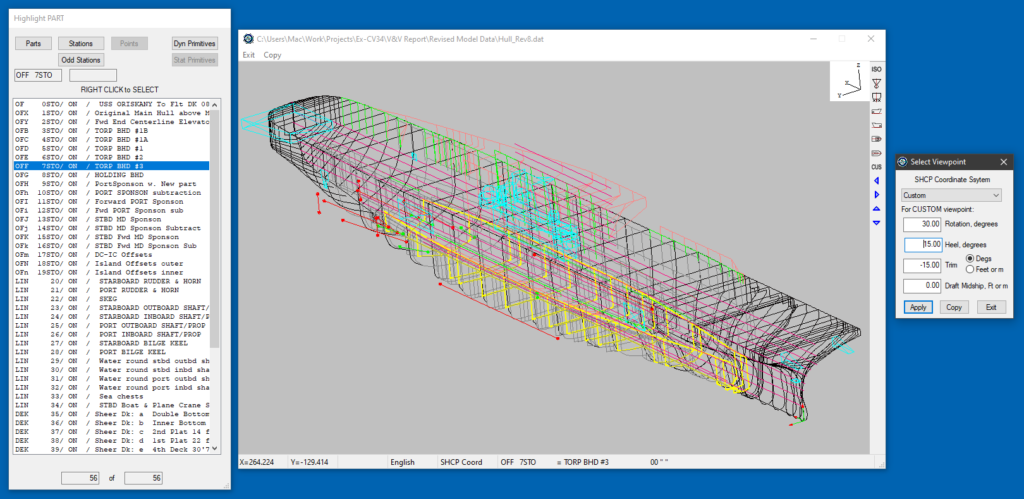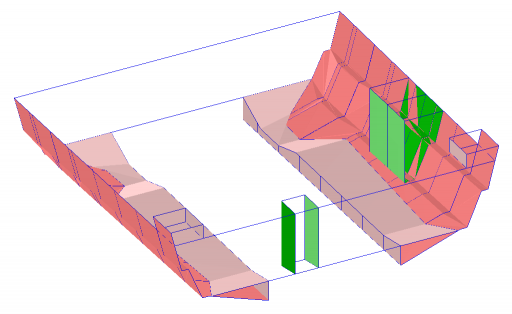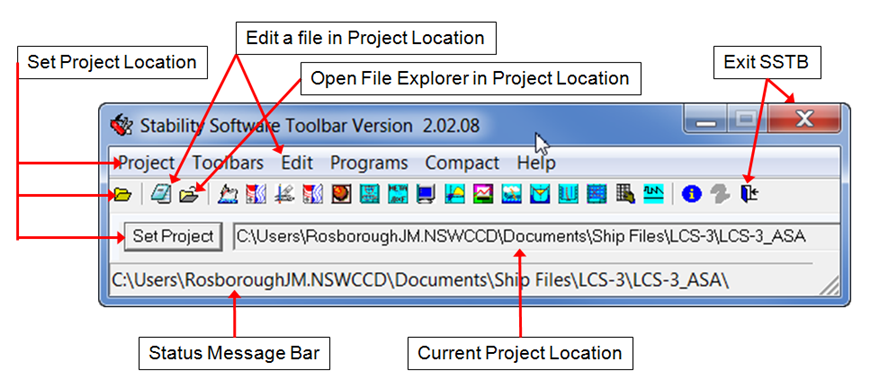SHCP Elements: Database Development Best Practice (22-Apr-24)
The Ship Hull Characteristics Program (SHCP) provides a suite of modules used to perform basic naval architectural calculations. The basis of the software is that there is a common hull, appendage, internal/external offset geometry, decks, and compartments used to support these calculations. The SHCP software is very flexible regarding the surface geometries that you can model using X,Y,Z offsets. However, the generation of appropriate offset geometry, decks, compartments, etc. is not addressed by the SHCP User Manual. This Element defines various ways to effectively construct an SHCP model sufficient to produce accurate hydrostatic and stability based calculations.
Conversion to Intel ifx Fortran Compiler
With the retirement of the Lahey Computer Systems and the recent announcement by Absoft Corporation that they will be closing in the near future, I have converted to the Intel oneAPI 2024 ifx Fortran compiler (the ifort classic compiler being depreciated). User interface and graphics support continues to be provided via https://winteracter.com/
ThruView V01.07.00 Released (15-Feb-24) – Free Download

ThruView is a wire-frame display tool for the viewing and interpretation of data for SHCP surfaces and appendages and also for XYZ point cloud data
that is often the precursor to SHCP station formatted data. It also supports the static and dynamic display of Picture geometric primitive shapes. The SHCP geometry model and the XYZ CSV point cloud data can be rotated about the midship/Z axis, trimmed, and heeled in either a Parallel or Perspective view. Program benefits include:
- Models may be any size. ThruView will allocate space necessary to view the model submitted.
- SHCP data is checked at multiple levels for acceptability with extensive reporting.
- Item highlighting is made easy with menu type direct access provided at the Part, Station, and Point levels.
- Comparison of the loaded model size against current SHCP size limits.
- Station curve representation may be ‘connect-the-dots’ (most forgiving ), Ship Data Table (SDT) generated points, or SDT points with curve interpolation.
Version 1.07.00+
- Conversion to Intel ifx Fortran compiler with associated minor revisions.
- Added ability to read and display 3D Lines data. This is a new SHCP capability that also supports the Series 2 LTag longitudinal point definition.
CompRender V01.42.00 Released

Version 1.42.00+ 24-Feb-24
- Conversion to Intel ifx Fortran compiler 2024
- Multiple user interface improvements, shortcomings and bug fixes applied.
Version 1.38.00 14-Oct-2021
- Added capability to display ASA artifacts ‘above’ the WLASA upper deck level as a overhead (OV) object in dashed outline.
- 3D View Compartments: Revised to display all available ASA artifacts associated with the compartments selected.
- Revised the organization of the DXF layers.
- Holes and portal display revised for those mostly horizontal artifacts.
- Revised the Build Script capability to be more intuitive in its use.
- Added buttons and menus to the Build Script capability for the drawing details that previously had been hard-wired. Now these values are exposed and the user can select the desired settings for the script. These settings don’t affect the settings within the program.
- Surface generation code revised which solved an inside surface display problem. The ComptGenLvl2 code was originally set up to cut the inside surface under the assumption that the inner surface was different from the outer surface. When inner and outer surfaces are the same, the previously cut outer surface mesh is now copied to the inner surface mesh and Y inner values set to 0.0. The ComptMeshYIPlanar routine now adjusts the same inner surface mesh for any Y planar value. Otherwise the routine generates a new inner mesh for the different inboard surface as before.
- Fixed problems with Hole and Portal adjacency checks in the Z direction.
- Fixed errors in the calculation of the average deck height values.
- Added capability to convert ASAP portal Z values (deck oriented) to ASA baseline portal Z height.
- Includes all updates from 1.34.00
Version 1.34.00 06-Jul-2021
- All ASA Artifact types are now viewable in 3D.
- Shaded surface section polylines can now be toggled on and off.
- Added 3D surface model viewpoint control via mouse. User can change rotation, elevation and distance of the eye-point by clicking and dragging the view with the mouse. Distance is controlled by the mouse wheel.
- Compartment centers can now be generated from CompRender bounding cube estimations.
- Level 1& 2 and Level 3 view port locations are stored and retrieved letting the user configure the location of the main graphics window and the supporting dialogs and menu-lists. These view ports will be restored to their previous arrangement based on the level of display selected.
- Dialog improvements & bug fixes.
Version 1.31.00 01-Jan-2021
- Revised the SurfFacetx routines to accommodate single sided facets in addition to double sided facets. The original implementation of shaded panels in the W3D model used double sided so that the panels would be visible from both sides. Single sided is needed if exporting a compartment or surface model in STL format since CAD programs are expecting STL files where all panel normals point typically outside.
- Added support for choosing ASCII or Binary STL file type in the Draw Parameters dialog. Binary is 5x smaller file size than ASCII.
- Added checkbox for selecting single sided facets in the 3D Views | Offset Surfaces and 3D Views | Compartments | Main & Sub Compartments dialogs.
- Added Module Mdl_Mesh to carry just added and future mesh variables and allocateable storage.
- Added Click-Wrap code for EULA acceptance. Updated menu to add Print EULA capability
- Fixed error where X window dimensions were being used to determine Y window size. This only caused zooming errors when the graphics window was very wide and zooming was invoked by clicking.
Version 1.30.00 16 Aug-2020
Adds new ‘Level 3’ 3D compartment display. The CompRender ‘Level 2’ compartment geometry display (full offset definition), introduced in version 1.26.04, has served as the geometry basis for the implementation of ‘Level 3’ compartment geometry display: Full Shaded Surface representation !! This view provides the following benefits:
- Clarity of compartment interpretation which surpasses the full Level 2 wire representation
- Ability to clearly evaluate the interface of compartment/ sub-compartment surfaces
- Demonstrate the effect of Sheer Deck references on compartment implementation
- Full control over the color and visibility of all 6 compartment surfaces
- Better interpretation of when inner & outer surfaces are not matching
- Visual compartment part/subpart identification via part blinking
How-To and Demonstration Videos Added to News & Publications !
Some quick How-To and more in depth Demonstration type videos are being added to the News & Publications page starting with a demo of the Draw Compartment function in the CompRender program.
Two How-To reports have been added which describe the integration of spreadsheet generated data and Rhino macros to generate data for SHCP Offsets: Rhino NACA Macro and Rhino ‘Wedding Cake’ Superstructure Macro.
Introducing SHCP Elements
The format of the SHCP geometry and module data has been around for a long time via the User Manual. What’s been missing is the ‘how do you really do this’ and the ‘tips and tricks’ that come with decades of model construction experience. We are proud to introduce SHCP Elements – an expanding collection of shorter, topic focused manuals that we hope will fill this information gap. Offsets DownSlope Modeling and Compartment Modeling are the first two being offered. Downloads available in News & Pubs
ASA Database Creation Training Completed at NSWCCD
Training for Advanced Stability Algorithms (ASA) Database Creation best practices course for NSWCCD C844 was completed in September 2019. This course provided face to face specialized training for the understanding of the ASA software and tools and proper model construction methods and verification techniques. Training included tutorial instruction, live software examples, and Q&A opportunities. Provided as part of the training was the “ASA Best Practices for Database Construction” manual. Spiral bound copies of this manual are available for $82.35 including shipping. Email me to arrange payment & shipping.
Phone & Email based Help Desk Service !
Often having the necessary software tools and being able to use them to their fullest extent are two different things. JM Rosborough Stability Consulting now offers phone and email based Help Desk services for the SHCP, FCCS and ASA suites of software. This service helps your firm maximize the efficiency of your dedicated staff by providing answers to such questions as:
- How can I make the software calculate/analyze/model my problem?
- Is there a software program or function that will let me do the following … ?
- Why am I not getting the results that I expected?
Check out this new cost efficient service to maximize the efforts of your firm today!
Navy Announces Findings On Sinking of World War I Cruiser USS San Diego
Background
JM Rosborough Stability Consulting, LLC provides software design, development & support, training, and consulting services for the SHCP (Ship Hull Characteristics Program) and the Stability Software Suite of SHCP pre- & post-processing software.
In addition, we can provide extensive support, database development and training for FCCS (Flooding Casualty Control Software) shipboard software and the ASA (Advanced Stability Algorithms) time-domain based progressive flooding software (FLMASA & FLMNet).
We believe that our extensive background in the design, development, application and daily use of these software can help you leverage your organizations efficiency in their application and use.

